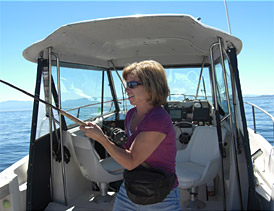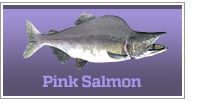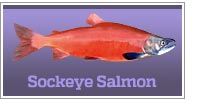Fishing For Salmon In Washington State
Guide to fishing for Atlantic, chinook, chum, coho, kokanee, pink and sockeye salmon in WA.
Washington state is renowned for its incredible salmon fishing opportunities, attracting anglers from around the world. Several salmon species migrate through the region's rivers and coastal waters, offering thrilling angling experiences and the chance to catch these prized fish.
Chinook Salmon

One of the most sought-after salmon species in Washington is the chinook salmon, also known as king salmon. These powerful and impressive fish can reach impressive sizes and provide anglers with thrilling battles. Anglers often target them by trolling with downriggers or casting spoons and crankbaits. Chinook Salmon, like all Pacific salmon, die after spawning. They grow large and put up a great fight when hooked. Fish for chinook with down riggers to troll around the thermocline. Use flashers, trailed with bait for best results. The current Washington state record for chinook salmon stands at over 44 pounds.
Atlantic Salmon

Known as the “king of fish”, Atlantic salmon live in both fresh and saltwater, which means they are anadromous. They are renowned for their impressive athleticism, and delectable taste. Native to the North Atlantic Ocean, these fish undertake extraordinary journeys from their natal rivers to distant feeding grounds in the open ocean and back again to spawn. In recent years, the allure of fishing for landlocked Atlantic salmon in lakes has grown in popularity. Landlocked Atlantic salmon in lakes exhibit similar behaviors to their sea-run counterparts, including feeding frenzies and impressive displays of strength when hooked. Anglers most often target landlocked salmon by trolling open water. The pursuit of landlocked Atlantic salmon also comes with a responsibility. Conservation efforts are essential to ensure the long-term sustainability of these populations. Anglers must follow local regulations, and support habitat restoration initiatives to safeguard the future of this cherished species.
Coho Salmon

Another species of salmon found in Washington is the coho salmon. These coho's can are often more available to be caught during the fall when they migrate closer to the shoreline. These acrobatic fish put up a fierce fight and are highly prized by anglers. Trolling with spoons, plugs, or flies is a popular method for targeting coho salmon. Coho Salmon are smaller in size compared to other salmon but still provide a thrilling fight when hooked. Coho salmon, also called silver salmon, are another prized species targeted by anglers in Washington. These fish are known for their aggressive nature and aerial displays when hooked. Coho salmon offer thrilling battles, often leaping out of the water and making blistering runs. They can be caught by trolling or casting near shore areas during their migratory periods. Use small spinners, or bait on a bobber setup. Good bait options include wax worms, minnows, shrimp, and nightcrawlers. Anglers often target Coho salmon in rivers such as the Snohomish River and the Queets River, as well as in the marine waters of the Puget Sound and the Strait of Juan de Fuca.
Kokanee Salmon

Kokanee salmon, a landlocked form of sockeye salmon, can be found in lakes. These fish are prized for their brilliant red color and tasty flesh. They are not the same as the ocean-run salmon species, but they still provide an exciting angling experience. Fish for them around structure with distinct drop-offs and depth changes. Typically kokanee average one to two pounds. They are plankton feeders and very sensitive to water temperature. They school in lakes at depths which remain ideal temperatures. Once this depth is identified, schools can be found where they are easily caught. Use small lures trolled at the appropriate depth. The can also be caught using corn, but the main way they are caught is using flashy lures which they attack when the lure intrudes their space. Kokanee salmon are known for their hard-fighting nature, making them a sought-after catch among anglers. Anglers can target kokanee salmon using techniques such as trolling with flashy lures or using downriggers to reach deeper waters where the fish reside.
Sockeye salmon, or red salmon, are highly prized for their rich flavor and deep red flesh. These fish migrate through Washington's rivers, including the Wenatchee River and the Okanogan River. Sockeye salmon fishing often involves targeting them as they stage in lakes before their journey upstream. Lake Wenatchee and Osoyoos Lake are popular spots for sockeye salmon fishing.
Pink salmon, also known as humpback salmon, are the smallest and most abundant salmon species in Washington. Every odd-numbered year, vast numbers of pink salmon return to the region's rivers to spawn. Pink salmon provide excellent fishing opportunities for both experienced and novice anglers, and they are often targeted in rivers such as the Skagit River and the Nisqually River.
Chum salmon, also called dog salmon, are known for their fighting abilities and aggressive strikes. While chum salmon are not as widely targeted as other species, they still provide an exciting fishing experience. Anglers can find chum salmon in rivers such as the Hood Canal and the Queets River.
Washington's diverse salmon species offer anglers an incredible fishing experience and the chance to reel in these prized fish. Whether targeting Chinook, Coho, Sockeye, Pink, or Chum salmon, Washington's rivers, and coastal waters provide a thrilling and rewarding salmon fishing adventure.
Salmon Fishing Waters in Washington
Washington is in the heart of the Pacific Northwest salmon fishing haven. Plenty of quality salmon abound in the coastal and inland waters of the state. The major rivers flowing into the Pacific are migration routes for salmon spawning. Many of the major lakes in the state have excellent populations of salmon. These major lakes include Alder Lake, American Lake, Baker Lake, Banks Lake, Cle Elum Lake, East Rapids Lake, Kachess Lake, Keechelus Lake, Lake Chelan, Lake Crescent, Lake Cushman, Lake Herbert G West, Lake Mayfield, Lake Merwin, Lake Sacajawea, Lake Sammamish, Lake Umatilla, Lake Washington, Lake Wenatchee, Lake Whatcom, Osoyoos Lake, Ozette Lake, Palmer Lake, Riffe Lake, Rimrock Lake, Rock Lake, Roosevelt Lake, Rufus Woods Lake, Silver Lake, Vancouver Lake, Wanapum Lake and Yale Lake.
Fishing for salmon in Washington
Atlantic salmon
World record: 79 lbs 2 oz
State Record: 14.38 lbs
Chinook salmon
World record: 97 lbs 4 oz
State Record: 68.26 lbs
Chum salmon
World record: 35 lbs 0 oz
State Record: 25.97 lbs
Coho salmon
World record: 33 lbs 7 oz
State Record: 25.27 lbs
Kokanee salmon
World record: 9 lbs 10 oz
State Record: 6.25 lbs
Pink salmon
World record: 14 lbs 8 oz
State Record: 15.40 lbs
Sockeye salmon
World record: 15 lbs 4 oz
State Record: 10.63 lbs
Click the images and links above for species details.
The state record Atlantic salmon was taken out of Green River.
The state record chinook salmon was caught in the Elochoman River.
The Satsop River produced the state record chum salmon.
The Quinault River produced the state record coho salmon.
Lake Roosevelt served up the state record kokanee salmon.
The state record pink salmon was taken from the Stillaguamish River.
The state record sockeye salmon was taken out of Lake Washington.


This 20-pound, silver salmon was caught in the Strait of San Juan by Mary Seaman - August 2007.
About The Pacific Salmon Family
Pacific Salmon are born in and remain in freshwater streams for the early years of life. The number varies by species. Afterward they migrate to the Pacific Ocean waters where they bulk up and prepare for their once in a lifetime spawning run up the freshwater stream where they were born. They will instinctively return to their birthplace, spawn and die. They are found in the streams which empty into the ocean, and adjoining ocean waters.
The preferred method for catching salmon is fly fishing. Depending on the activity level, salmon may be caught on wet or dry flies. For more details check here for articles about fly fishing.
Salmon Organizations
Washington Salmon Fishing
The preferred method for catching salmon is fly fishing. Depending on the activity level, salmon may be caught on wet or dry flies, as well as a variety of other lures and baits.
Salmon fishing waters and information, by state.
101424*
WASHINGTON










